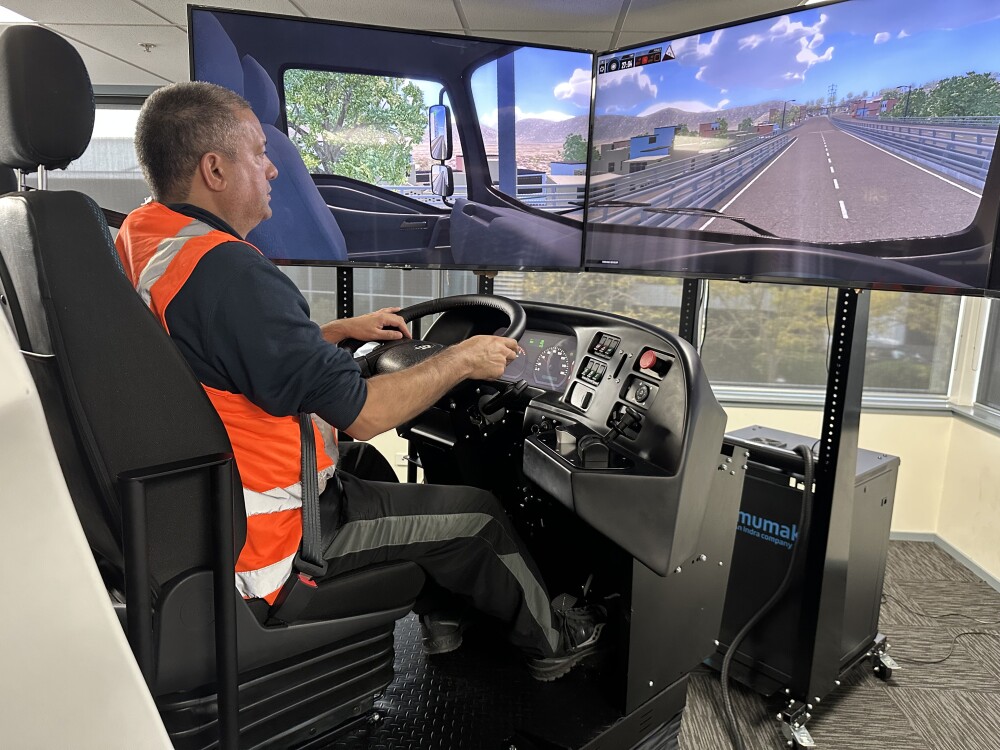New truck simulators put beneficiaries in the driver's seat
Matiu has always wanted to be a truck driver and, in a country with a shortage of truckies, you may wonder what’s stopped him from getting behind the wheel. Until now, the answer was several daunting barriers that few know about.
For a start, it costs more than $2,000 to qualify, there are significant unit standards to learn and a period of six months on a learner before Matiu can sit his full license. A compounding factor is that trucking companies are reluctant to sponsor candidates through a long and uncertain process without a return.
The introduction of truck simulator training through +IMPAC's Whiti Supply Chain Programme is a game changer because it cuts the standdown period between learners and full license to just two weeks, significantly reducing costs and nurturing aspiring drivers through the unit standards and road code learning and assessment. A far safer way to train aspiring drivers, the simulator also helps produce safer novice drivers.
"I was worried about the cost and the time it would take to get a truckies license. The unit standards are a lot to remember, there's more theory than I expected, and getting practise time in a truck is almost impossible," says Matiu, who was referred to +IMPAC's Whiti programme by the Ministry of Social Development (MSD) after he returned to New Zealand from Korea, where he taught English.
+IMPAC's Whiti two-week programme, which also included practical training on actual trucks, not only accelerated Matiu's qualification as a truck driver, it also gave him the confidence and belief in his ability to get behind the wheel.
"I realised I can do this," says Matiu. "The truck simulator made me a safer driver, improved my concentration and taught me skills like staying in my lane and how to engine brake. I had no idea how important things like engine braking and safety are. It was good practice for hazards like pedestrians, horses, and cyclists. Getting fast-tracked like this is very exciting because, at last, I can get a job as a truck driver."
+IMPAC's Whiti Supply Chain Programme, which (in partnership with the logistics industry and MSD) has already revolutionised the safety training qualifications of new forklift operators through virtual reality simulator technology, recently introduced the world-leading truck simulator. Matiu was one of the pilot candidates to undergo training on the simulator.
"The truck simulators empower candidates to climb behind the wheel of a truck with the competency and belief they need to do the job," says Sam Eyre, +IMPAC truck training course lead and himself no stranger to teaching novice drivers after a decade of doing so in the New Zealand Defence Force.
"The truck simulators are a far safer way to train new drivers because they are not going straight from classroom to real truck. They go from classroom to simulator to truck, so we're not just putting newbies behind the wheel of four tonnes of steel. They step into the real thing, already knowing the process—the dashboard isn't a strange collection of buttons and levers."
Not only do the truck simulators fast-track driver training for a lot less money, but they also make the career more attractive to young people. Until now, it has not been a career that has attracted young people due to the obstacles.
"Our truck driving workforce is ageing," says Sam. "Most drivers are in their forties and fifties. With the simulator there are fewer obstacles, and the technology gamifies the learning process—training becomes stickier."
The traditional methods of training truck drivers in New Zealand involve a significant amount of time learning at home, usually alone. Candidates are left to their own devices with little in the way of tutoring and mentoring through the process.
"They no longer have to do this independently because they have instructors and assessors walking them through the training. They don't have to sit online theory tests on their own. They achieve their full class 2 license in two weeks," says Sam.
In addition, candidates are taught skills like preparing a CV. "It's as much an employment course as a driver's course."
While students are on the truck simulators, trainers sit behind their consoles to monitor training in real-time and, unlike traditional driver training, there is the ability to introduce all kinds of hazards, from cyclists to snow and other dangerous weather conditions like sunstrike and, importantly, wind velocity.
The technology provides real-time assessments of where the driver has performed well or poorly, as well as mistakes and efficiencies with an objectivity that only solid data can provide. The simulator also puts drivers through the experience of what it's like to drive drunk or fatigued, and correct gearing and exhaust braking.
The session reports are helpful in training new drivers and assessing the skills of experienced drivers because, with data, there is no room for subjectivity.
Matiu is excited for the future. "Now I can do what I enjoy and get paid good money to do it."

